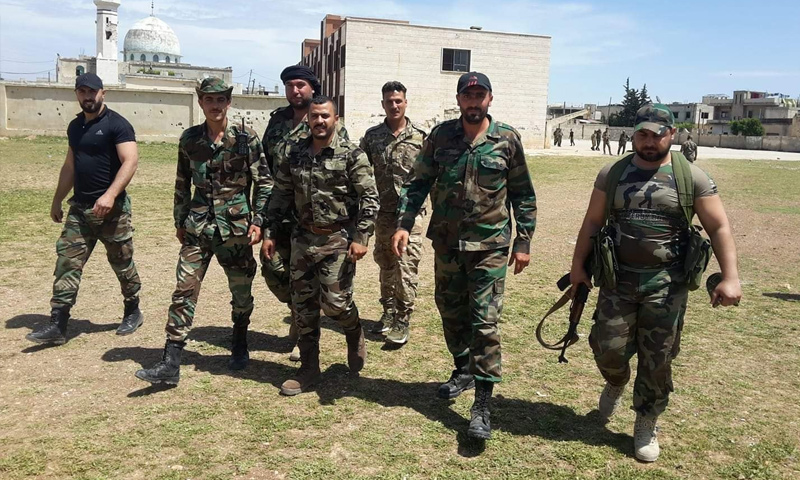On June 6, the opposition factions have initiated a wide-range military operation against the Assad forces in northern rural Hama, under which they controlled three strategic sites deep in the areas held by the Syrian regime ـــ Jbain, Addahra School and Tel Meleh.
The battle had various names, changing from one faction to another, where the National Front for Liberation (NFL) gave it the name “Repelling the Invaders,” HTS called it the “Battle of al-Muʿtaṣim biʾllāh al-Madani,” while Jaysh al-Izza (Army of Glory) dubbed it “Breaking the Bones.”
The military operation, which finally came to be called the al- Fath Ul Mubeen (The Manifest Victory), had a slow rise and on different stages, where it developed into a series of incursions, “ighara” as the opposition factions refer to it.
The last of these incursions took place on Monday, June 17, where the factions, starting from the three sites, have attacked the towns of Kafrhood and Jalamah in northern rural Hama, controlling several weapons, munition and killing Assad forces’ personnel.
Since their control by the opposition factions on June 6 to the day, the Assad forces have failed to regain the three sites, which constitute a triangle that the factions managed to preserve despite the intensity of the bombing on the part of the Syrian regime’s and the Russian warplanes.
Quoting a military leader, Enab Baladi’s correspondent for rural Hama reported on June 20 that Assad forces since dawn have attempted invading the three towns, the triangle of northern rural Hama, but failed to achieve any progress while losing personnel, who got killed by the opposition factions upon entering the area.
The correspondent added that the attempts mounted to three with no advancement on the part of Assad’s forces, a tank of which was destroyed by the opposition factions, in addition to personnel who were killed during the incursion.
According to the leader, the residential blocks in the three towns have been leveled to the ground. As for the tactic, the opposition factions chose flying checkpoints which they set up every now and then to keep the sites under their control, backed by ambushes, which caught three of the Assad forces’ groups.
Kafr Nabudah Front Excluded from the Battle
Since the factions took over the towns of Tel Meleh, Jbain and Addahra, 13 days ago, the reality of the territorial control has changed in northern rural Hama, for the Assad forces ceased their advance on the Kafr Nabudah town’s axis to bridge the gaps represented by the Kafrhood and Jalamah towns.
Despite the extensive shelling undertaken by Assad forces against the fronts in northern and western rural Hama, they failed to regain what they have lost earlier, for the latest of the attacks that the factions launched is different from any other as it shifted the confrontations to the areas held by the Syrian regime, guarding the areas under their control, such as Kafr Nabudah and the village of Qasabiyeh, southern rural Idlib.
In a former interview with Enab Baladi, Mustafa Ma’arati, the spokesperson of the Jaysh al-Izza (the Army of Glory), operating in rural Hama, said that the fronts of Tel Meleh and Jbain are “bone breakers”, as they “rubbed [the regime and Russia’s] nose in the dirt and crushed their might.”
Ma’arati added that Tel Meleh and Jbain are ruling areas, for they block the Muhradah- al-Suqaylabiyah, the reason why the regime wants to regain them as to reopen the road between the two areas.
Tel Meleh is a hilltop, where the opposition factions’ militants are fortified. In its northern part, the town of Jbain is located.
The sites, Tel Meleh and Jbain, that have been recently controlled by the opposition factions are located in northern rural Hama. They are considered strategic for two reasons: The first is that being in control of these towns, the opposition factions are obstructing the arrival of Assad forces’ reinforcements in the town of Kafr Nabudah and the villages in southern rural Idlib.
The second, however, relates to the area’s identity, for they have been affiliated with the regime for years and the opposition factions failed to advance deep in them despite their many attempts.
Same Model in Kabanah
The territorial dilemma facing Assad forces on the ground in Northern Syria is not limited to the triangle in northern rural Hama, as it applies to northern rural Latakia, in the direction of the strategic village of Kabanah.
Starting about a month ago, the Assad forces failed to take over the village, viewed as the key to the opposition-held areas in northern rural Latakia and western rural Idlib.
On the Kafrhood and Jalamah fronts, northern rural Hama, the confrontations are led by the Tiger Forces under the command of Suheil al-Hassan, Brigadier General in Assad Forces. In the rural Latakia fronts, the military operations are, however, directed by the 4th Division, led by Ghiath Dala, also a Brigadier General in Assad forces.
The Kabanah village, which the Assad forces are trying to control, is located on the most strategic hilltops in rural Latakia and is considered the most prominent of the opposition’s strongholds in the al-Akrad mountain.
The strategically important village bestows those in control of it with the ability to monitor massive areas of western rural Hama and Idlib, in addition to villages in northern rural Latakia.
The village separates Idlib governorate from the coast and is considered its gate from the west; it also overlooks al-Ghab Plain, Jisr al-Shugur and the Turkish borders, as well as a massive portion of the governorates of Hama, Idlib and Latkia.
The map below represents territorial control in Syria: color green is allocated to opposition and red to the Syrian regime.











